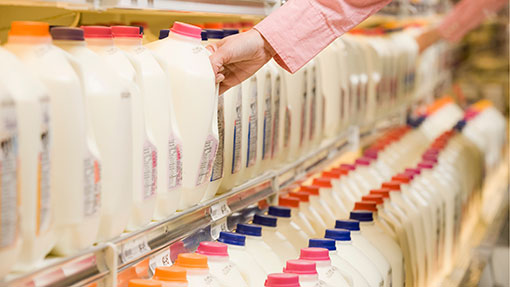Supermarkets compared on farmer milk prices

As another supermarket joins the milk price war, Farmers Weekly investigates how each retailer supports dairy farmers and if the cost cutting has been passed down to the farm gate.
This spring the biggest supermarkets launched a price war, slashing the cost of milk in most stores to £1 for four pints.
Last week, premium retailer Waitrose joined in too. Supermarket bosses have promised farmers will not be affected.
 Charlie Taverner
Charlie TavernerFarmers Weekly
Business reporter
Two years ago, Farmers Weekly produced a report like this, asking retailers to be open with farmers.
In the summer of 2012, the dairy sector was in crisis. Today’s mood is one of concern, not panic. Farmgate prices are mostly above 30p/litre, rather than 26-27p/litre, and there is more awareness of how world markets affect the UK.
Supermarkets compared
See our table breaking down how much each retailer pays, who they buy from and how well they are doing supporting farmersBut record milk production this year has caused dairy commodity prices to plunge to 2012 levels, causing one major processor to cut its price by 4p/litre already.
With half of all the UK’s milk bottled for supermarket shelves, liquid sales should be a buffer to the battering of global forces.
Has the price war hit the farm gate?
What has changed
The most striking change since 2012 is the price of milk on the shelf.
After a flurry of cuts this spring, seven of the 10 biggest supermarkets now sell four pints of milk for £1 or less – equivalent to 44p/litre.
Two years ago only Iceland, Aldi and Lidl were charging that little.
Today’s farmgate prices are about 3-4p/litre higher, so supermarkets have sacrificed their margins.
NFU Scotland policy manager Kylie Barclay says on-shelf prices reflect the commercial pressure retailers face.
“Retail prices are always disappointing because they don’t reflect the value of such a quality product,” she says.
See also: Read more on milk prices
“We have concerns that such low prices place significant pressure on milk processors to meet retailer demands and make it more difficult to lift the price paid to farmers.”
Despite the criticism it attracts, Tesco has a big, dedicated supply pool and invests heavily in dairy.
Sainsbury’s, the Co-op, Waitrose and M&S also have cost-of-production contracts that pay a premium price and offer transparency.
Of the bigger retailers, Asda and Morrisons come out worse for not having dedicated supply schemes.
The other concern is a lack of support from fast-growing discounters Aldi and Lidl, which charge customers the lowest shelf price.
NFU dairy board chairman Rob Harrison said cost-of-production models had stood the test of time.
“I would like to see milk purchasers underwriting futures or enabling farmers to lock in some of their milk at a fixed price,” he said.
More transparency is needed. Waitrose says it pays a market-leading price but would not reveal it. Iceland won’t give any details at all.
And the still-unanswered question is how much milk retailers buy outside dedicated dairy groups.
The future
Dairy farmers get a better deal from supermarkets today, particularly as milk prices have improved.
But coveted cost-of-production models need be used more widely. And cheap prices on the shelf must not feed down to the farm gate.
As the UK enters a volatile post-milk-quota era, the large liquid market is a vital asset. That strength must not be eroded by battles for grocery market share.
